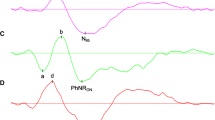Abstract
The pattern electroretinogram and the visual evoked potential were recorded simultaneously with various stimulus fields and artificial scotomata of increasing sizes. In contrast to an earlier study, a smaller check size (20′) and two stimulus field sizes (20° × 20° and 10° × 10°) for the scotomata were used. With a concentric decreasing stimulus field, a reduction of both the pattern electroretinogram and visual evoked potential was found. Both showed a simultaneous reduction of amplitudes, but, compared with the amplitude in the full field, the reduction was more extensive for the pattern electroretinogram at each test field size. This implies a greater contribution to the pattern electroretinogram from more eccentric retinal parts. An artificial central scotoma of increasing size in the 20° × 20° field had less influence on the pattern electroretinogram than on the visual evoked potential. The percentage amplitude loss of the visual evoked potential was more pronounced. The visual evoked potential was eventually abolished by a scotoma size from 10° × 10° upward, while the pattern electroretinogram was still registrable. When scotomata of similar size were introduced in a smaller (10° × 10°) field, percentage pattern electroretinogram and visual evoked potential amplitude losses were less separated than in a larger (20° × 20°) test field.
Similar content being viewed by others
References
Armington JC, Corwin TR, Marzetta W. Simultaneously recorded retinal and cortical responses to patterned stimuli. J Opt Soc Am 1971; 61: 1514–21.
Sokol S. An electrodiagnostic index of macular degeneration. Arch Ophthalmol 1972; 88: 619–24.
Groneberg A, Teping C. Pattern evoked cortical potentials to simultaneous stimulation of both eyes. Doc Ophthlmol Proc Series 1981; 27: 313–21.
Hess RF, Baker CL. Human pattern-evoked electroretinogram. J Neurophysiol 1984; 51: 939–51.
Katsumi O. Hirose T. Tsukada T. Effect of number of elements and size of stimulus field on recordability of pattern reversal visual evoked response. Invest Ophthalmol Vis Sci 1988; 29: 922–27.
Katsumi O. Tanino T, Hirose T. Objective evaluation of binocular function with pattern reversal VER. Acta Ophthalmol 1986; 64: 691–7.
Sakaue H, Katsumi O, Mehta M, Hirose T. Simultaneous pattern reversal ERG and VER recordings. Invest Ophthalmol Vis Sci 1990; 31: 506–11.
Török B. Microcomputer-based recording system for clinical electrophysiology. Doc Ophthalmol 1990; 75: 189–97.
Berninger T, Arden GB. The pattern ERG. In: Heckenlively JR, Arden GB, eds. Principles and practice of clinical electrophysiology of vision. St. Louis: Mosby, 1991: 291–300.
Riemslag FCC, Ringo J. Spekreijse H, Verduyn LH. The luminance origin of the pattern electroretinogram in man. J. Physiol 1985; 363: 191–209.
Drasdo N, Thompson DA, Arden GB. A comparison of pattern ERG amplitudes and nuclear layer thickness in different zones of the retina. Clin Vision Sci. 1990; 1: 415–20.
Berninger T, Schuurmans RP. Spatial tuning of the pattern ERG across temporal frequency. Doc Ophthalmol 1985; 61: 17–26.
Horton JC, Hoyt WF. The representation of the visual field in human striate cortex. Arch Ophthalmol 1991; 109: 816–24.
Wässle H, Grünert U, Röhrenbeck J, Boycott BB. Cortical magnification factor and the ganglion cell density of the primate retina. Nature 1989; 341: 643–6.
Trick GL. Pattern evoked retinal and cortical potentials in diabetic patients. Clin Vision Sci 1991; 6: 209–17.
Author information
Authors and Affiliations
Rights and permissions
About this article
Cite this article
Junghardt, A., Wildberger, H., Robert, Y. et al. Pattern electroretinogram and visual evoked potential amplitudes are influenced by different stimulus field sizes and scotomata. Doc Ophthalmol 83, 139–149 (1993). https://doi.org/10.1007/BF01206212
Accepted:
Issue Date:
DOI: https://doi.org/10.1007/BF01206212




